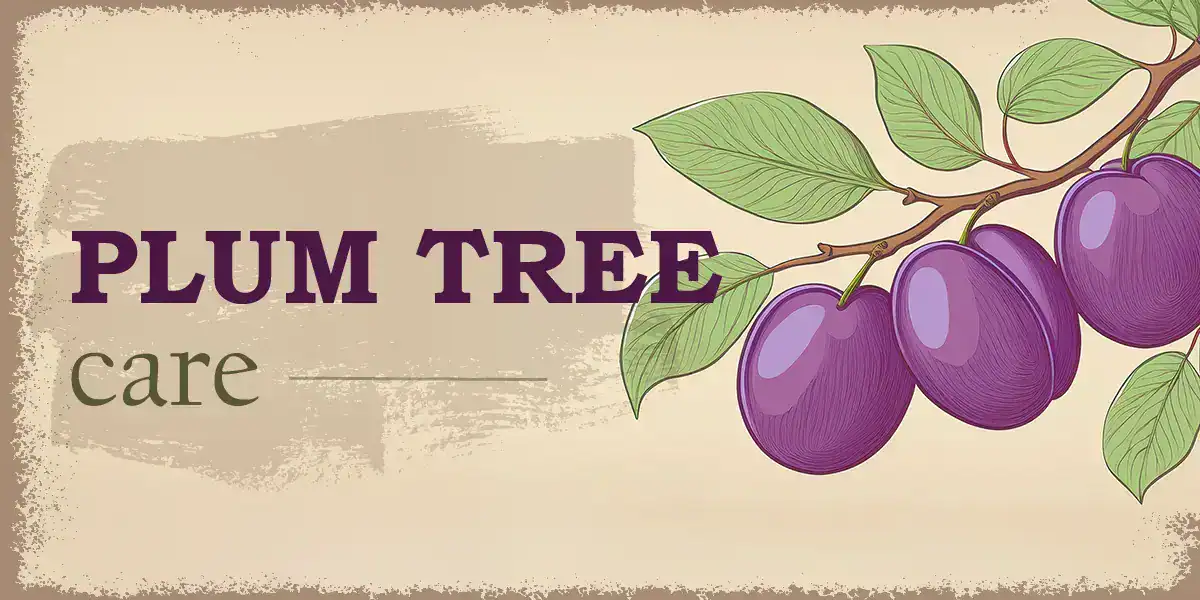This ancient fruit has so many uses! You can pickle it, dry it, dice it into salads, eat it fresh off the tree, or bake it in a Christmas pie for Little Jack Horner.
The plum dates back thousands of years.
- European plums (Prunus domestica) trace to Western Asia and Europe.
- Japanese plums (Prunus salicina) originated in China but were cultivated extensively in Japan before spreading to other regions.
Both types contributed to the delicious varieties we have today.
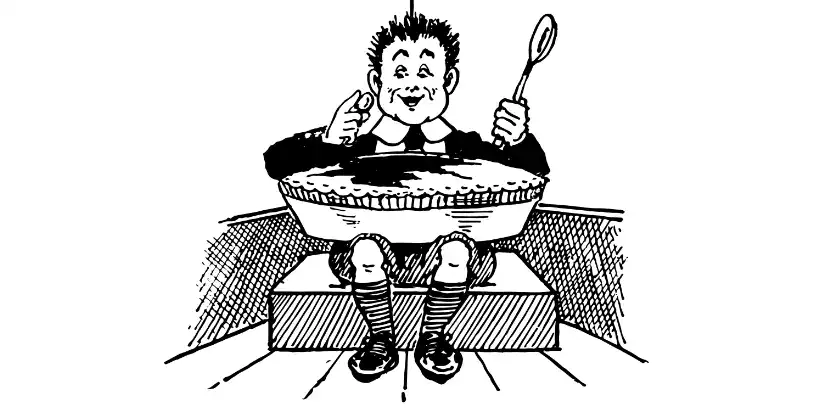
Little Jack Horner would approve of the plum tree in your yard. The more plums, the bigger the pie!
Why the Plum Tree Belongs in Your Garden
While historically popular in temperate areas, modern plum varieties thrive in Southern California. Why? Because plum trees love:
- Plenty of sunlight
- Minimal frost exposure
- Well-draining soil that prevents root rot
Does that sound like a fit for your Southern California yard?
Plums also need a certain number of chill hours (between 32°F and 45°F) to set fruit, but many varieties are adapted to low chill conditions.
Best Varieties for Southern California
Top picks for warm climates include:
- Santa Rosa: A popular Japanese plum with sweet, tangy fruit. Requires minimal chill hours and is self-fruitful.
- Beauty: Produces small, sweet fruit and adapts well to warmer areas.
- Methley: Another Japanese variety with juicy, red-fleshed fruit.
- Hollywood: This dual-purpose variety has striking red leaves and sweet plums, making it decorative and practical.
- Burgundy: Known for its rich flavor and low maintenance, this variety is perfect for beginners.
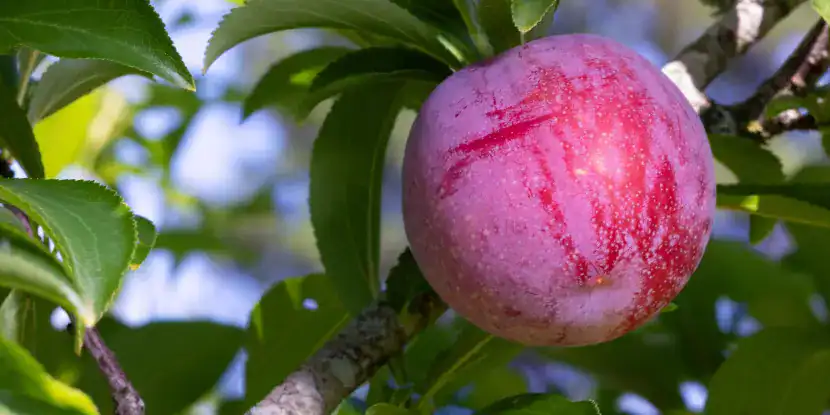
Santa Rosa plums are sweet and tangy, and require minimal chill hours.
Mature Tree Size
- Standard Plum Trees: These typically reach a mature height of 15–25 feet, with a similar spread, and require adequate space for their expansive canopy.
- Dwarf Plum Trees: Grow to a mature height of 8–10 feet with a similar spread, making them an excellent choice for smaller gardens or container planting.
Optimal Growing Conditions
Light
Plum trees need full sun for at least 6–8 hours daily. Proper light exposure boosts flower and fruit production.
Temperature
Most plum varieties can handle mild Southern California winters. Select varieties with low chill hour requirements (150–300 hours).
Soil
Plum trees prefer:
- Well-drained, sandy/clay loam soil.
- A pH between 6.0 and 7.0.
Amend the soil with compost to ensure it’s nutrient-rich. Avoid waterlogged soils, which can lead to root rot.
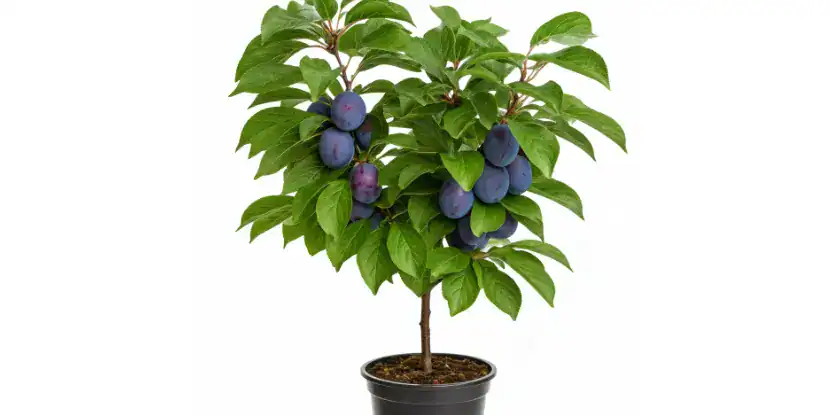
Dwarf plum trees can be grown in containers.
Propagating Plum Trees
Plum trees are usually propagated through:
- Seeds (takes longer and requires stratification).
- Grafting onto rootstock (faster and ensures desirable traits).
Consider purchasing grafted saplings from a reliable local source for consistent growth and fruiting.
Steps for Planting
- Select a sunny area with good air circulation. Avoid planting near large trees to prevent competition for resources.
- Dig a hole twice as wide as the root ball and slightly deeper than the root system.
- Mix compost or well-rotted manure into the soil to provide nutrients.
- Place the tree in the hole, ensuring the graft union (the knobby part at the base) is 2–3 inches above the soil line.
- Fill the hole with soil, gently firming it around the roots. Water thoroughly to remove air pockets.
- Add a 2–3 inch layer of mulch around the base to retain moisture and suppress weeds (keep mulch away from the trunk).
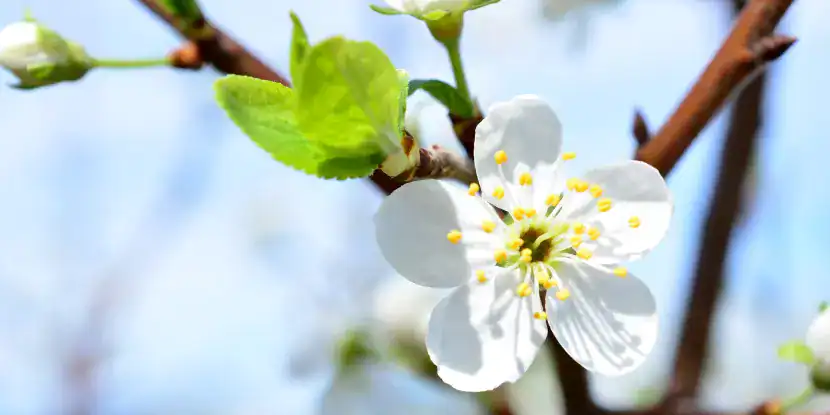
Close-up of a plum tree blossom in spring.
Plum Tree Care
Pollination
Determine whether your tree needs a pollinator:
- Self-fruitful varieties (like Santa Rosa) don’t require a second tree.
- Cross-pollinating varieties need a second compatible tree nearby for fruit set.
Check the tag on your tree when purchasing, or ask your nursery.
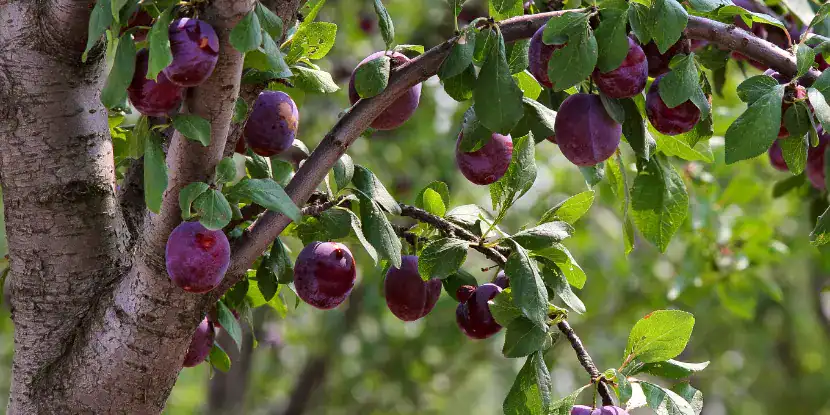
A mature plum tree bears a bounty of fruit.
Water
- Water young trees deeply every 7–10 days during the growing season.
- Mature trees may need weekly watering during summer, but adjust based on rainfall.
Fertilizer
- Use a balanced fertilizer (10-10-10) in early spring before new growth begins.
- Avoid over-fertilizing, which promotes excessive leaf growth with less fruit production.
Pruning
Regular pruning improves light penetration, air circulation, and fruit production.
- Winter Pruning (dormant season): Remove dead or diseased wood and shape the tree.
- Summer Pruning (after fruiting): Trim excessive growth to maintain size.
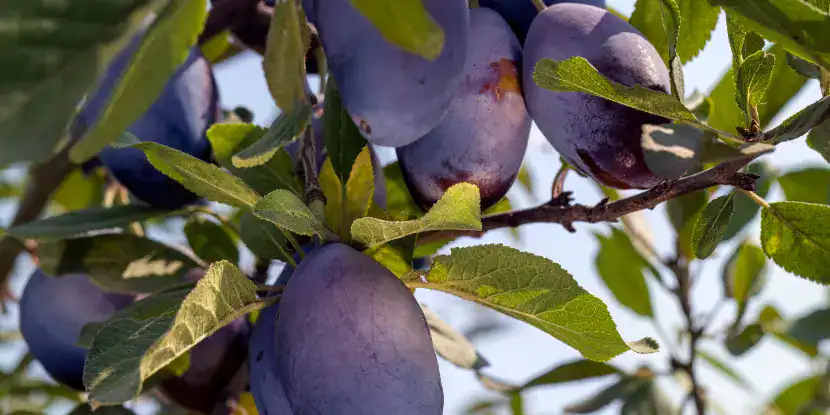
Juicy purple plums ripen on the tree.
Pests & Diseases
Common threats include:
- Pests: Aphids, plum curculio, and scale insects. Use pest-resistant sprays or introduce beneficial insects like ladybugs.
- Diseases: Brown rot and leaf spot. Practice good hygiene by removing fallen fruit and leaves.
Harvesting Plums
Time from Flower to Harvest
Most plum trees take 3–6 years to bear fruit. Once flowering begins in early to mid-spring, fruit ripens within 3–5 months.
When to Harvest
- Plums should feel firm but yield slightly when pressed.
- Their color will deepen, depending on the variety (e.g., Santa Rosa turns a deep reddish-purple).
- Avoid picking green fruit. Plums ripen best on the tree!
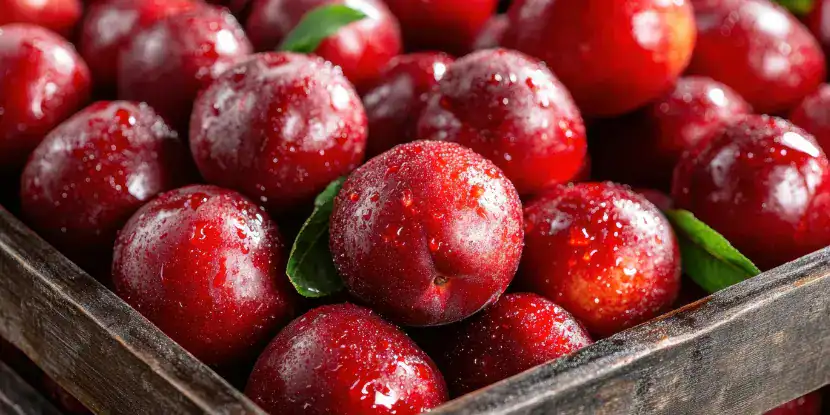
These freshly harvested red plums are ready for the fruit bowl.
FAQs: Plum Tree Care
Q: How much space does a plum tree need?
Standard plum trees need 18–20 feet of spacing, while dwarf varieties need 8–10 feet.
Q: Can I grow plums in containers?
Dwarf varieties grow well in large pots (minimum 18 inches in diameter).
Q: What are chill hours, and why do they matter?
Chill hours refer to time spent in temperatures between 32°F and 45°F. Plums need chill hours for proper flower and fruit development.
Q: How often should I fertilize my plum tree?
Once each spring is enough. Apply a balanced fertilizer to avoid overfeeding.
Q: Do I need to thin the fruit?
Yes, thin clusters to 4–6 inches apart to improve fruit quality.
Q: Why isn’t my plum tree fruiting?
Possible reasons include young age, lack of pollination, or insufficient chill hours.
Q: How long does a plum tree live?
A healthy plum tree can live 15–20 years, though peak fruit production occurs in its first 10–15 years.
Q: Are plum roots invasive?
No, plum tree roots aren’t considered invasive but can spread up to 25 feet wide. Avoid planting near foundations or underground utilities.

